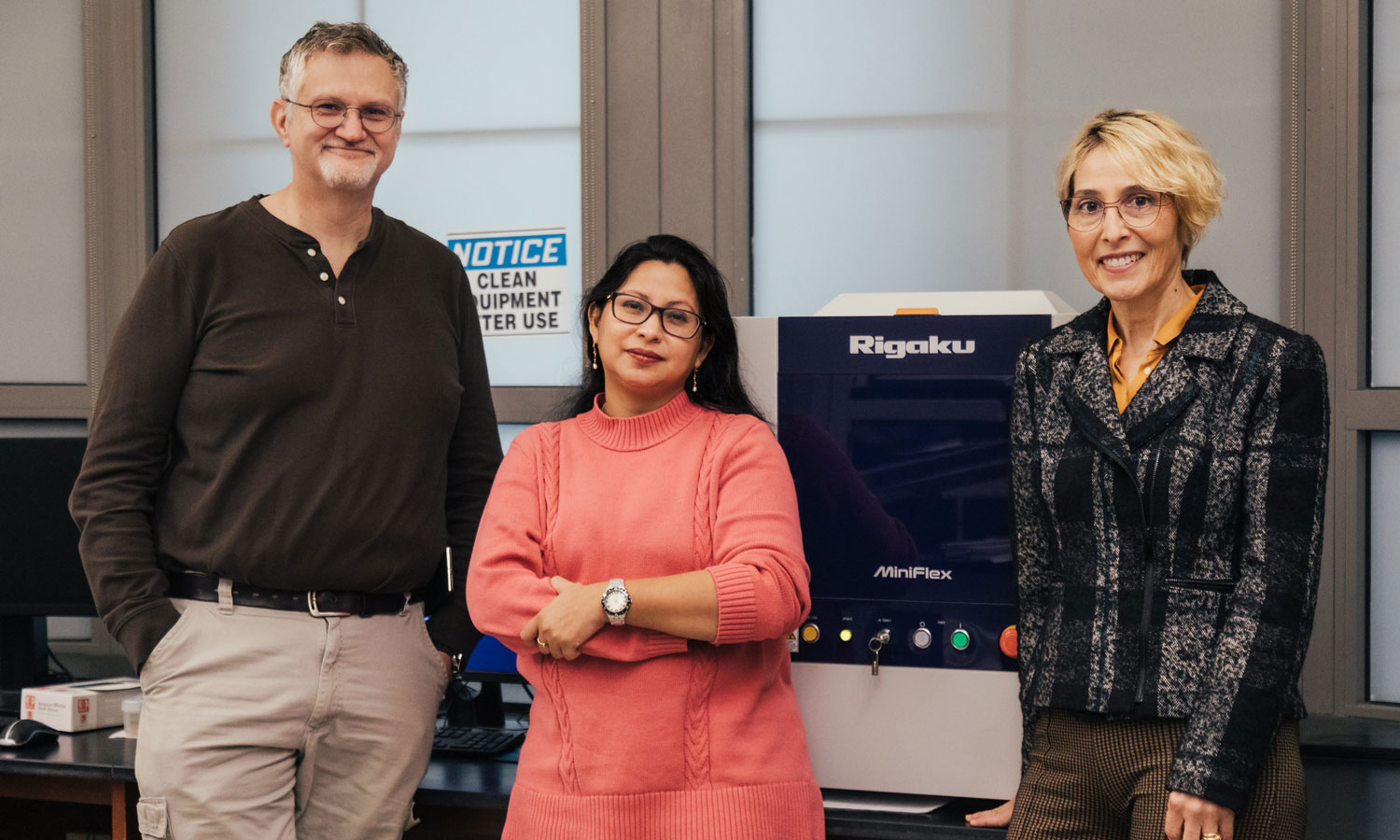Researchers seek to find new ways of building permanent magnets, reducing dependency on rare-earth elements

Radhika Barua, Ph.D. and fellow VCU professors Afroditi Filippas, Ph.D., and Everett Carpenter, Ph.D., are part of a team of VCU researchers working to create new types of magnets.
Permanent magnets play an indispensable role in renewable energy technologies, including wind turbines, hydroelectric power generators and electric vehicles.
Ironically, the magnets used in these “clean energy” technologies are made from rare earth elements such as neodymium, dysprosium and samarium that entail environmentally hazardous mining practices and energy-intensive manufacturing processes, according to Radhika Barua, Ph.D., mechanical and nuclear engineering assistant professor. Access to these rare earth magnets is also heavily reliant on China and demand for them is expected to grow as the U.S. seeks to meet net-zero carbon emissions by 2050.
“That anticipated demand poses a challenge to U.S. decarbonization goals as the rare earth elements are characterized by substantial market volatility and geopolitical sensitivity,” Barua says. “This is where our project comes in.”
Barua and fellow VCU professors Afroditi Filippas, Ph.D., and Everett Carpenter, Ph.D., are part of a team of VCU researchers working to create new types of magnets. By using additive manufacturing, more commonly known as 3D printing, they hope to create replacements for those permanent magnets composed of rare earth elements that are made from materials readily available in the U.S.
China mines 58 percent of the global supply of rare earth elements used to make neodymium magnets that are widely used in consumer and industrial electronics, the U.S. Department of Energy (DOE) noted in a February 2022 report. That dominance grows throughout the manufacturing process with China accounting for 92 percent of global magnet production, the DOE estimates.
“It would be ideal if we could manufacture the same magnets with the same characteristics without using rare earth elements,” says Filippas, who teaches electromagnetics at VCU. “It would be even better if we could make these magnets using additive manufacturing techniques.”
VCU researchers are trying to do that in collaboration with the Commonwealth Center for Advanced Manufacturing (CCAM), which brings university, industry and government officials together to tackle manufacturing challenges. The professors are conducting much of their work at CCAM’s lab in Disputanta, Virginia.
“We have access to equipment that we would not have access to at VCU,” Filippas says of the benefits of the CCAM partnership. “They provide that level of expertise using the equipment and understanding the process.”
The project is funded by the VCU Breakthroughs Fund and CCAM.
Barua is working with Carpenter, a chemistry professor, on the materials science part of the project. Filippas is focusing on data analytics and is helping develop a monitoring process to ensure the newly-crafted replacement magnets are viable.
In addition to providing a more stable source of supply, Barua says the replacement magnets could also bring environmental benefits. Providing an alternative to rare earth magnets would involve less hazardous mining techniques while also reducing emissions and energy consumption.
The replacement magnets are made by filtering particles of iron, cobalt, nickel and manganese through a nozzle where a laser fuses them together through a process known as direct energy deposition. That metal 3D printing approach can make complex shapes while minimizing raw material use and manufacturing costs, Barua says.
“Right now, we’re printing straight lines just to see what we’re going to get and see if we can even print them,” Filippas says. “Are we getting the composition of the materials that we want? It’s a slow painstaking process towards freedom from reliance on rare earth materials.”
Barua says using additive manufacturing allows researchers to create a unique microstructure layer-by-layer instead of simply making magnets from a cast. Researchers do not expect their replacements to mimic the full strength of rare earth magnets, but they hope to produce mid-tier magnets that are as close as possible to current magnets.
Carpenter adds their new magnets could potentially be smaller and weigh less than rare earth magnets, which could lead to numerous benefits.
“This reduction would be a big savings to the automobile manufacturing industry, for example, where every ounce matters,” Carpenter says. “In an S-Class Mercedes, there are over 130 magnets used in sensors, actuators or motors. This approach could save pounds of weight which translates into fuel efficiency.”
Barua says the team is working to establish the feasibility of their new magnet-making process. They are trying to get the microstructure of the new magnets just right and are using additive manufacturing to fine-tune their magnetic properties, Barua says.
“When artificial diamonds, cubic zirconia, was synthetically produced in the lab, it changed the entire diamond industry,” Barua says. “That’s exactly what we’re trying to do. We’re trying to make synthetic magnets.”
Categories Electrical & Computer Engineering, Mechanical & Nuclear EngineeringTagged Afroditi V. Filippas, AI / Autonomous Systems / Computing, Radhika Barua, Sustainability: Materials / Energy / Environment
